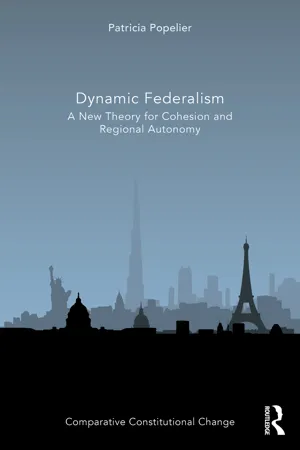
Dynamic Federalism
A New Theory for Cohesion and Regional Autonomy
Patricia Popelier
- 292 pages
- English
- ePUB (mobile friendly)
- Available on iOS & Android
Dynamic Federalism
A New Theory for Cohesion and Regional Autonomy
Patricia Popelier
About This Book
This book offers a new theory of federalism.
The work critically discusses traditional federal theories and builds on theories that focus on the dynamics of federalism. It offers a definition of federalism and federal organizations that encompasses both new and old types of multi-tiered system. Unlike traditional federal theory, it is well-suited to research both multinational and mononational systems. It also takes into account the complexity of these systems, with bodies of governance at the local, regional, national, and supranational level. The book is divided into three parts: the first part outlines the contours of dynamic federalism, based on a critical overview of traditional federal theory; the second part develops comprehensive indexes to measure autonomy and cohesion of multi-tiered systems; and the third part focuses on the dynamics of federal organizations, with a special focus on institutional hubs for change.
Dynamic Federalism will be an essential resource for legal, social, economic, and political scholars interested in federalism, regionalism, and de/centralization.
Frequently asked questions
Part I
1What is federalism? In search of building blocks for a new federal theory
- 1 Anna Gamper, ‘A “Global Theory of Federalism”? The Nature and Challenges of a Federal State’, (2005) 6 German Law Journal 1297.
- 2 Francesco Palermo and Karl Kössler, Comparative Federalism: Constitutional Arrangements and Case Law (Hart, 2017) 2–3.
- 3 Ibid 38.
- 4 John Kincaid, ‘Editor's Introduction: Federalism as a Mode of Governance’, in J. Kincaid (ed), Federalism (Sage 2011, Volume 1) xxi.
1.1 The importance of defining federations
1.1.1 Why a pragmatic approach to the definition of federal systems is insufficient
- 5 Palermo and Kössler (n 2) 3.
- 6 Gemma Sala, ‘Federalism without Adjectives in Spain’, (2013) 44 Publius: The Journal of Federalism 109–134.
- 7 Ferran Requejo, Multinational Federalism and Value Pluralism (Routledge 2005) 82.
- 8 Daniel J. Elazar, Exploring Federalism (University of Alabama Press, 1987 – ed. 1991) 42.
- 9 Tsvi Kahana, ‘Canada’, in Dawn Oliver and Carlo Fusaro (eds), How Constitutions Change. A Comparative Study (Oxford, Hart 2011) 12–13, 37.
- 10 Eugénie Brouillet, ‘The Supreme Court of Canada: The Concept of Cooperative Federalism and its Effect on the Balance of Power’, in Nicholas Aroney and John Kincaid (eds), Courts in Federal Countries: Federalists or Regionalists? (University of Toronto Press 2017)151. The Canadian Constitutional Act 1867 itself does not explicitly define its structure, although the Preamble underlines the desire of the Provinces to be ‘federally united’.
- 11 Section 1(1) Indian Constitution.
- 12 Mahendra Pal Singh, ‘India’, in Oliver and Fusaro (n 9) 183. See also Palermo and Kössler (n 2) 41.
- 13 Art. 1, 3 and 5a Swiss Constitution.
- 14 Thomas Fleiner, ‘Constitutional Revision: The Case of Switzerland’, in Xenophon Contiades (ed), Engineering Constitutional Change, (London, Routledge 2013) 337. See also Giovanni Biaggini, ‘Switzerland’, in Oliver and Fusaro (n 9) 305.
- 15 Kenneth C. Wheare, Federal Government (Oxford University Press 1953) 1.
- 16 Art. 3 Constitution of Bosnia and Herzegovina.
- 17 Palermo and Kössler (n 2) 6.
- 18 See for example Art. 2 Mexican Constitution, Art. 2 (1) Nigerian Constitution, Art.1 Iraqi Constitution.